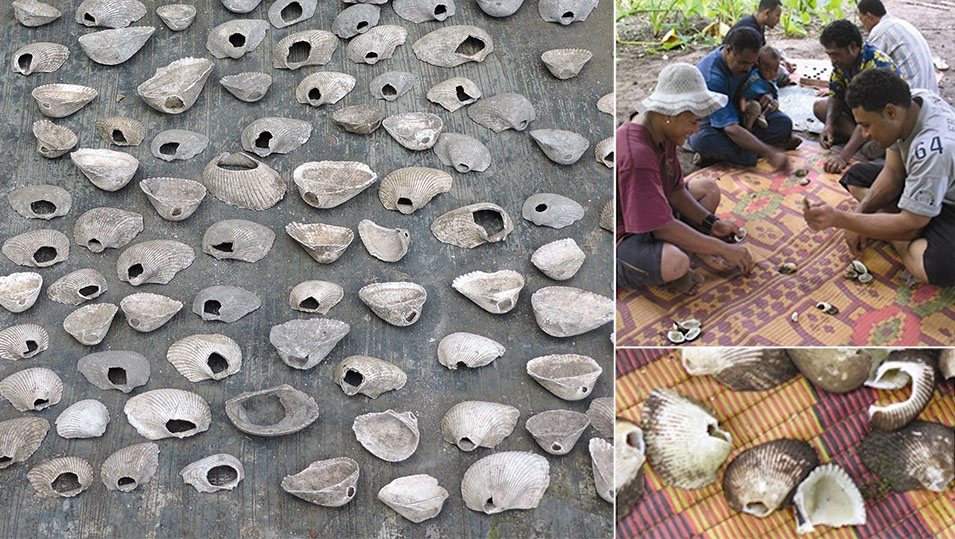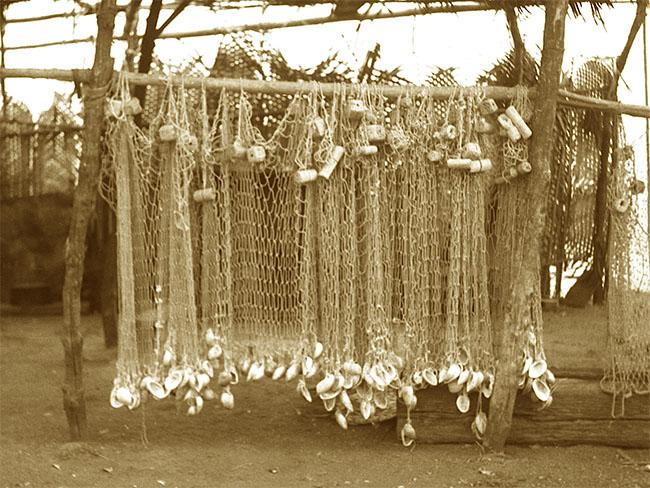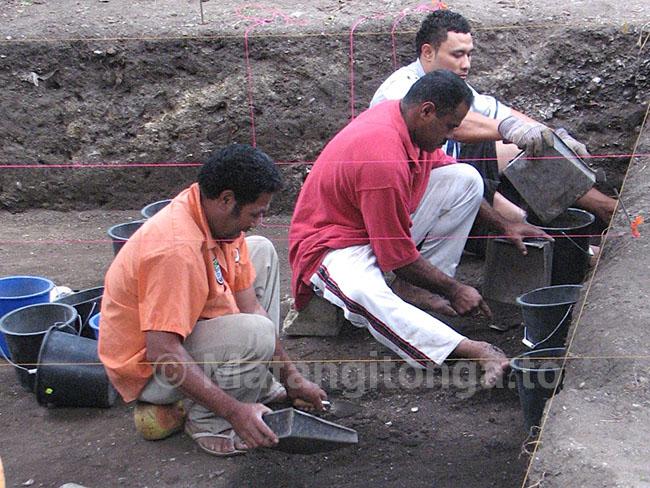
 _
_ 
By David Burley and Sean Connaughton
There are rare moments on an archaeological project when, without expectation, an event or discovery will occur providing extraordinary insight into the past, or where the past connects with the present in an utterly astonishing way. Both occurred in late July of 2007, as we were carrying out archaeological excavations in the village of Nukuleka at the northeast entrance to Fanga ‘Uta Lagoon. This story is about the documentation of a shell game, taupita, but a shell game, as we found out, with an almost 3000-year-old history. It also is a story that binds Tonga’s earliest Lapita ancestors to the people of Nukuleka today.
A previous Matangitonga article, The first Tongans, has described the abundance of evidence identifying Nukuleka as Tonga’s first village. Uranium thorium and radiocarbon dates establish first landfall here by 900 BC or shortly thereafter. These first Tongans brought with them all of the necessities of life to settle new found islands, including an economy integrating taro and other types of agriculture with fishing and collection of shell fish from the reef. The indications for this at Nukuleka are impossible to miss. Thick deposits of ancient refuse including shell, fish bone, ceramic fragments and other artifacts are mixed within organically rich sediment. These deposits, in fact, provide much of the soil for Nukuleka gardens today. Archaeological excavations at Nukuleka were undertaken early in the 1960s with additional projects in more recent years. It is clear from these endeavors that the bivalve species Anadara antiquata (kaloa’a) was abundant and a preferred food source for the earliest inhabitants. Though populations of this species have diminished, it continues to be an appreciated delicacy, sold at the Nuku’alofa fish market and commonly served at feasts or as part of Sunday fare.
The importance of Anadara to early Tongans went beyond consumption as part of a daily meal. With slight modifications to the lip of the shell, individual valves became tools for peeling taro, bark, or for use in scraping other materials. Anadara shell scrapers are one of the most abundant artifacts in early Tongatapu sites. Our excavations recovered still another category of Anadara artifact, its use not so apparent as the scraper. The bivalve hinge for the Anadara shell is covered by a hump-like prominence, technically referred to as the umbo. On specimens at Nukuleka, and a few other sites on Fanga’Uta Lagoon, large numbers of Anadara had the umbo removed, leaving a hole in its place. Logically, we assumed, this hole was for stringing or for attachment, most likely as weights to some type of net. This was illustrated in an early 1950s photograph of a net from New Caledonia. And net fishing at Nukuleka in 2007 continued to provide an abundance of fish for the village. But scepticism remained. The sheer numbers of these specimens seemed well beyond the need for net weights. And they also occurred in a household refuse heap, a situation difficult to explain.
Our 2007 excavation project at Nukuleka hired a crew almost entirely from the village. It was a good group of men who worked hard, and who took interest in the project and what we were finding. The work day included tea-time and lunch breaks, where the crew played checkers or cards, always with faka-Tonga type vigour and the ruckus that inevitably results.

Yet there was another game for these men to play if the checkerboard was in use or the cards left home. This was taupita, described by the men as a “war with shell”. But it wasn’t any type of shell, it was Anadara antiquata valves taken from the excavation fill we had removed from the site.
The game of taupita involves two players sitting opposite each other, each having an equal number of Anadara shells at the outset. As the game begins, the challenger holds the Anadara valve by the lip with the inner side up. The opponents shell is positioned on the ground with inner side down. Using as much force as possible, and the umbo as a hammer, the player strikes downward on the umbo of the stationary shell. If the shell breaks, another is set in place and the player continues. If the shell fails to break, or the player’s shell fractures, the opponent becomes the striker. Taupita is a fast, back and forth game of individual wars with all of the gusto of cards or checkers. A winner is declared when a player’s shell runs out. As entertaining as the game was to watch, far more intriguing, and quite unexpected, was its by-product. This was a heap of broken shell refuse, but where several of the Anadara valves had their umbo removed. These were identical to the ones we had been excavating from the site, and the ones we had been interpreting as net weights.
Taupita is a popular game in Nukuleka, as we were told by the crew. Shell could be collected from the beach with little difficulty, and anyone was able to play, though most often it was a game for the young. We recorded the rules and we had our crew play the game with freshly collected shells, not the fossilized material being pulled from the site. The results remained the same. We re-examined collections from other early settlements on the lagoon, finding additional evidence for taupita at Ha’ateiho and Pea. And we canvassed as many people as possible beyond Nukuleka, seeking new knowledge of the game or insight into its history. In that we met with failure, the game being played at Nukuleka alone.
With the project of 2007 in the rear-view mirror, we can identify many important discoveries from the excavations, not the least being a documentation of Nukuleka’s considerable antiquity. But none are as unique as taupita. A tea-time observation fortuitously identified a game having a 3000-year-old history with important implications for archaeological interpretation. At the same time, it all seems surreal. In an almost mystical way, we had been watching an undeniable connection of the Nukuleka past with the Nukuleka present. In the same location, and probably for the very same reasons, our crew and their Lapita-age ancestors had played taupita. Archaeologists get to experience such things ever so rarely.
Dr. David V. Burley is a Professor of Archaeology at Simon Fraser University in Burnaby, BC, Canada. He has carried out archaeological studies in Tonga.
Dr. Sean Connaughton works as an Archaeological consultant in Vancouver. In 2007, he was a PhD student at Simon Fraser University working as a field supervisor on the Nukuleka project.






